Manuscripts Etc.
| CLOSE WINDOW |

|
The following items are drawn from the William Faulkner Foundation Collection at the University of Virginia's Albert and Shirley Small Special Collections Library (http://small.library.virginia.edu/). |
|
When asked about the novel, Faulkner almost invariably called As I Lay Dying a "tour de force." He had his own definition for this phrase, telling a class at the University of Virginia on 11 March 1957 that if a book is "all complete" in your imagination and putting it on paper is "just a matter of sitting down and swatting it out," "then it's a tour de force." About this novel he said on a number of other occasions that he wrote it "in about six weeks without changing a word" (Faulkner at Virginia, 27 April 1957; also 15 April 1957, 5 June 1957, and so on). The first and last pages of the manuscript (below left and center) essentially support half of that claim: the dates he recorded on them — 25 October 1929 and 11 December 1929 — are just over six weeks apart. On the other hand, according to the date on its final page, his typescript (below right) wasn't finished until January 12, 1930, eleven weeks after he began writing. Comparing the words in these two versions of the text won't support the claim that he changed none of them: while the novel's unforgettable last line is exactly the same in both manuscript and typescript, he added two phrases to the penultimate paragraph, presumably as he typed it And even on the manuscript pages themselves, many words are changed: on that first page, for example, note the revisions, excisions and insertion, including the way "Tull" was originally called "Turpin." 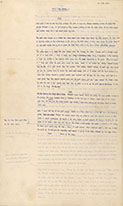 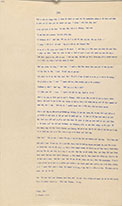 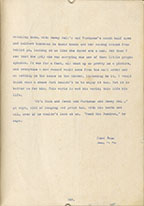 Among the other character names that were changed as he wrote were Tull's wife Cora, who was initially "Anna Turpin"; Armstid, initially "Starnes"; and Mosely, initially "Ackens." Compared to other of his novels, however, both the manuscript and typescript of As I Lay Dying show fewer signs of revision and reorganization; only five manuscript pages, for example, had to be renumbered. One of the most heavily revised manuscript pages is page 31 (below left), from the sixth Darl section, where after describing how Cash finishes the coffin the narrative comes back to Darl himself, lying under "a strange roof, thinking of home." It took Faulkner a few tries to get the rhythm he wanted for Darl's ontological questionings, but even on this page the changes are fairly minor. The next page (below center), where Cash lists his reasons for beveling the edges of the boards, also contains revisions, but no major ones. And on the next page (below right) we see how he got Vardaman's one-line attempt to comfort himself (while disconcerting most readers) exactly right the first time – though the back of page 42 also contains the same line, on a page numbered 32 instead of 33, so he may not have initially intended Cash's list to precede it. 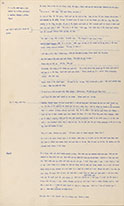 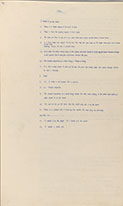 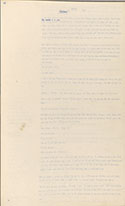 On the three pages below is Addie's one section, as it was originally written in the manuscript. You can compare them to the published text for yourself, but make sure you note one very significant difference at the beginning and end. In the manuscript, whenever she recalls her father's philosophy of life, he says that "the reason for living was to get ready to die." This idea would be familiar to most of the Protestants in Faulkner's Yoknapatawpha; in the section before, for example, Cora Tull smugly reminds herself that God "offers the salvation through our trials and tribulations." In the typescript, however, Addie's father speaks the words readers of the novel are familiar with, though they are hardly reassuring: "my father used to say that the reason for living was to get ready to stay dead a long time"; she isn't getting "ready to die," but "ready to stay dead." 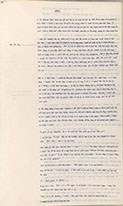 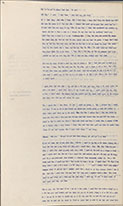 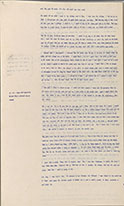 Vardaman's "fish" (page 33) is doubtless the novel's most dramatic use of white space, but elsewhere are other examples, smaller but still very suggestive, of how As I Lay Dying is a visual as well as a verbal experience. On the second page of Addie's section (above, center) there is an opening in the middle of the eighth paragraph that represents the place from which people enter the world. Faulkner made sure the typescript version of the passage (below left) preserves this space. (The //// slash marks on this page and elsewhere in the typescript are the way Faulkner typically cancelled words and phrases when he typed his manuscripts for publication; they also provide more proof that he continued to change words as he worked on the novel.) At the other end of life from that opening in Addie's section is the space into which the dead go, represented in the novel graphically by the coffin that appears in Tull's description of Addie's funeral. Faulkner drew coffins in both the manuscript and the carbon copy of the typescript that he kept for himself when he sent the typed version off (below center and right). 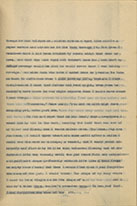 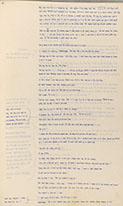  Emptiness, absence, holes — these are major thematic elements in the novel. And in at least two instances, Faulkner drew additional attention to them by increasing his use of white space. The manuscript's first use of the unwritten-on page is at the end of the first section (above, top), where the whiteness between the "chucks" of Cash's adze embodies silence. The record preserved on the typescript version of that page (below, left) suggests Faulkner decided at the moment of typing it to make readers conscious of absence on a vertical as well as a horizontal axis. The novel's last use of such space isn't in the manuscript at all. Below center is the section near the end of the story where Vardaman sits in the darkened and empty square in Jefferson while waiting for his sister to finish in the druggist's. When a stray cow clops past him and leaves, her former presence heightens the sense of absence. Faulkner made changes in the words of this passage when he typed it, but also added four blank spaces, making the cow's "clopping" echo the adze's "chucks" visually. Coming and going, the novel uses wordlessness to brilliant effect. 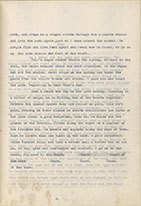 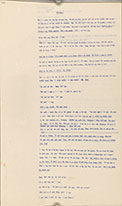 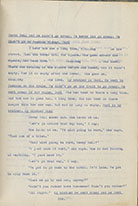 Citing this source: |
